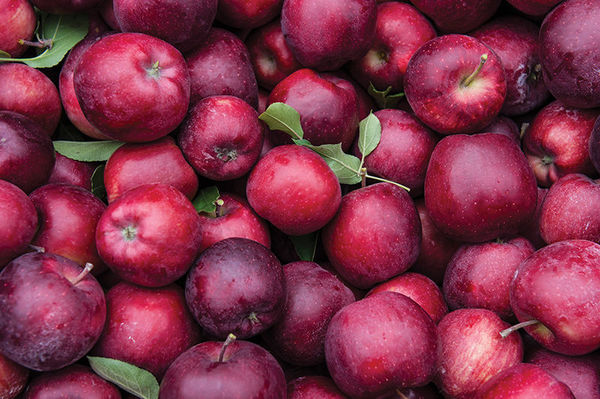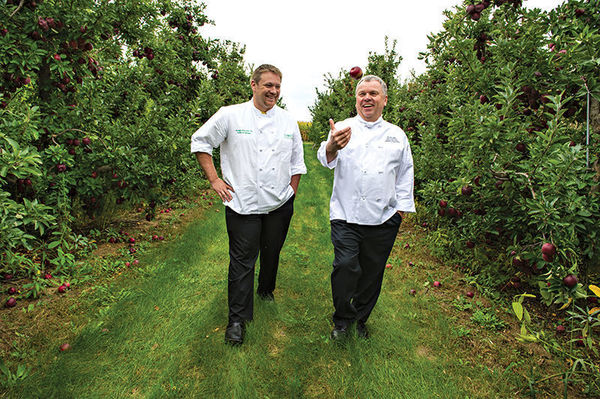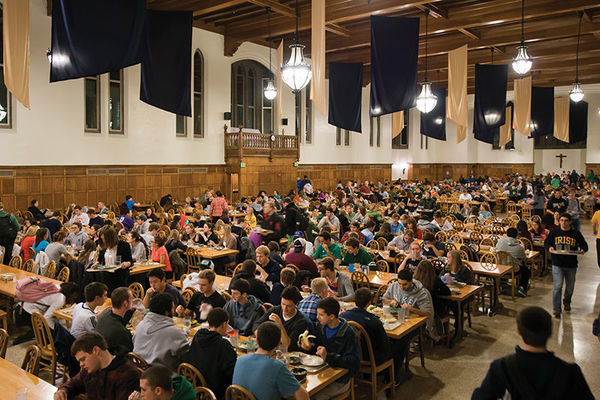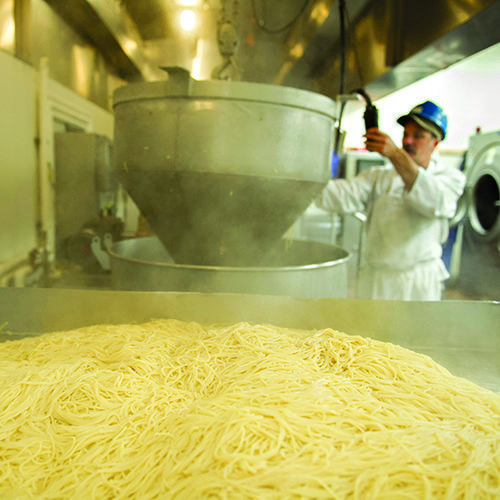Let’s begin with the honeybees that swarm Rodney and Jeanette Winkel’s Grandview Orchards in Berrien County, Michigan, from mid-April until early May, carrying life-giving pollen from peach to apple to tart cherry blossom — 240 colonies of them trucked up from Florida each spring.
They buzz from tree to tree on the Winkels’ 740 acres while the mowing begins in the orchards and the asparagus rises nearby. So much depends upon the delicate work of the bees, like the delivery of fresh fruit to Notre Dame’s loading docks from the first cherry harvest of summer through the Rome apples that ship in time for pie season in late October.

A wine-dark, cream-flecked Red Delicious falls into the emerald grass at my feet with a pleasing thud as the barn-jacketed Rodney and his brother, Barry, talk about the government regulations and labor issues that have shaped their life’s work. The Mexican pickers here at Grandview Orchards listen to rancheras as they toil, the polka beats pulsing toward us from several rows away. Behind Rodney, massive Jonathan trees that have outgrown their profitability lie uprooted as if by a tornado’s surgical strike, awaiting the axes and saws that will convert them into chips for smoking.
The Winkels and their ancestors have grown fruit and vegetables in southwestern Michigan for three generations, contributing to a harvest that once made this area the national leader in crop diversity. The U.S. Department of Agriculture still rates Michigan as the country’s second most agriculturally diverse state, and a group called Support Local Agriculture based nearby claims Michigan’s “Fruit Belt” as the world leader in non-citrus fruit production.
Bees are vital here. As boys, Rodney and Barry raised them to pay for college. Their younger brother, Kevin, relied on bees’ help when he cultivated the Early Chief, a strain of America’s most popular apple, the Red Delicious, that Rodney and many of his neighbors still grow. When I bite into one it occurs to me that this version of the Red Delicious really lives up to the name. Rodney catches my reaction. “We will guarantee that our apples taste a heck of a lot better than those cottonballs coming out of Washington!” he thunders with mock-bravado.
And wait, Barry says, grinning. “Wait until the starch goes to sugar.” Which is exactly what will happen in the few days it takes for these edible rubies to find their way to students in Notre Dame’s North and South dining halls.
It ain’t just apples
Much has changed in U.S. agriculture since Holy Cross brothers lit Notre Dame’s first cooking fire in November 1842. South of campus, most Indiana farms raise industrial corn or soybeans. These days, the University community should count itself blessed to have been founded just across the state line from America’s Garden of Eden.

Apples were one of the first subjects on executive chef Donald Miller’s mind when I met him in the test kitchen down in the basement of North Dining Hall to ask how Notre Dame feeds its small army of students, faculty, staff and visitors as many as 24,000 meals each day.
The straight answer is that it employs some 150 skilled cooks and hundred more dedicated preppers, administrators, greeters and housekeepers. But that’s too easy.
So: Almost a decade ago, under the leadership of ND Food Services’ beloved former director, the late David Prentkowski, Notre Dame began to seek out local sources for its food and food-related purchases using what Miller calls the “dartboard” system: “Find a source that’s as close as we know,” assuming cost and quality are at least as favorable, he explains. “And if we find one closer, then we’ll change to that.”
Today Notre Dame spends $5.6 million each year on local products, representing nearly half of its annual grocery bill — not bad at all, Miller says, considering how undergraduates aren’t even present for most of the growing season. “Local” in Notre Dame’s definition means Indiana and its immediate neighbors, Michigan, Illinois, Kentucky and Ohio, plus Wisconsin, whence originates the bulk of Notre Dame’s cheese.
Fresh fruits and vegetables come mostly from Berrien County growers like Grandview Orchards, but the list of local goods runs considerably longer than my imagination, nearly 3,000 separate items in Food Services’ inventory. Potatoes hail from Wisconsin, rather than Idaho. Midwestern mushrooms arrive by way of a national distributor with a facility in Illinois. Ketchup, diced tomatoes, chili sauce and other processed tomato products all come from Redgold in Elwood, Indiana.
The Hoosier State also accounts for 83 percent of the school’s dairy purchases and most of its pork. Even the lake perch served at Greenfields comes from Bell Aquaculture, a state-of-the-art Indiana operation striving to compensate for the once-plentiful species’ near-collapse in the Great Lakes.
But what about, say, dishwashing chemicals? Joliet, Illinois. Plasticware? Kalamazoo.
Apples taught chef Miller an important lesson about going local: Tell people what you’re doing. Students were accustomed to the picture-perfect varieties from the massive farms and packinghouses of the Pacific Northwest, where the arid climate requires heavy irrigation to bring a crop to fruition but limits the insects and blight that can affect an apple’s eye appeal.
In fact, Michigan apples look pretty good when they’re not held to some standard of Platonic appleness that’s achieved only in Washington and Oregon. But when Notre Dame switched over in 2006, the students balked. Then Food Services posted signs to explain the choice for local. “Boom,” Miller says. Apples started moving again. “And the flavor was better,” he adds, nodding to every culinarian’s favorite preoccupation.
Ah, if only an executive chef could focus on the rewarding sensory experiences of cooking and serving good food — “The crackling in the sauté pan for a proper sauté! The snap of a vegetable cooked properly!” Miller enthuses — but when you’re responsible for what’s on the menu at more than a dozen different cafes and restaurants all linked to a 24-hour delivery operation like Food Services, other important considerations arise.
“When I first started out in ’68, you worried about quality and costs,” Miller says. The Wisconsin native worked in the restaurant and hotel business, and taught cooking and related courses like food sustainability at Joliet Junior College before coming to Notre Dame in 1987 to run the Morris Inn’s kitchen. His promotion to executive chef in 2004 coincided with the storm-surge of campus interest in the ecological sustainability of the University’s day-to-day operations.

Quality and cost are still paramount, he says, but now students want to know more about what’s on their plate. “Where was it sourced or produced? How was it produced? How was it delivered? What’s the carbon footprint? How do they treat their employees? So we spend a lot of time visiting the different sites and following up as opposed to just reading it off a brochure.”
Thus my visit to Grandview Orchards isn’t solely for my benefit. Miller and his lieutenant, chef Giuseppe Macerata, are here, too, learning about the fresh apples that make their way by the hundreds into the dining hall serveries, the Grab ’n Go lunches, the pies and tarts that pâtissière Laura Johnson and her team back at Notre Dame’s pastry shop will bake for restaurants and catered events all over campus.
When we say goodbye to Rodney Winkel, the chefs pocket a few beauties for a show-and-tell with the apprentice cooks and culinary school interns training in ND’s kitchens. They talk about buying applewood chips for the giant smoker in the University’s butcher shop and bringing home two hardwood harvesting bins marked “Grandview Orchards” in which they’ll put fresh apples at mealtimes, one bin for each dining hall.
“It’s amazing to me, as we have moved away from a rural society, that a lot of our people in town don’t know where their food comes from,” Winkel had said. How to educate them, he doesn’t know. To the chefs, this seems like a good start.
Homecoming
I climb into Barry Winkel’s red Dodge pickup truck for the three-minute ride to his part of the family business, the packinghouse and distribution hub in tiny Millburg that operates under the name Greg Orchards & Produce. The company has contracts with some four to five dozen growers in Michigan, Indiana and Illinois, and handles peaches, blueberries, plums, cherries, pears and apricots, too, Barry explains inside, shouting over the metallic clacking of the conveyor belts and computerized sorters. A typical apple delivery comes in a flatbed truck loaded with about 20 collection bins. Each bin contains 20 bushels, or 840 pounds of apples. The apples move by forklift around back to be cooled if it’s a hot day, then are washed and sorted on their way to the packing team that awaits with nets, bags, boxes and crates.
“That part of the business hasn’t really changed since my grandfather’s time,” the 64-year-old Winkel says. One thing that’s new is the controlled atmosphere storage rooms that enable Greg to supply its customers as far afield as Dallas, Texas, from one harvest to the next. Nitrogen generators reduce the oxygen levels in each room down to about 2 percent, slowing the ripening process, while light applications of diphenylamine and 1-methylcyclopropene ensure that when the apples “wake up” they’re as colorful and crisp as the day they were picked.
About twice a week in-season, a semi arrives from South Bend’s Stanz Foodservice and fills with Greg’s fruit as well as vegetables from Maat Produce just up the road. The ensuing relay — which distributes those semi loads into delivery trucks at the Stanz warehouse out by South Bend Airport — serves Notre Dame and its many venues along with such local restaurants as LaSalle Grill and The Carriage House.
Stanz is a family operated, full-service food distributor. Its president, Mark Harman ’84, is the grandson of co-founder Emil Stanz, and its business relationship with Notre Dame spans much of the company’s 90-year history. Notre Dame is Stanz’s biggest produce customer and buys much of its coffee and meat through Stanz as well as its canned and frozen goods, so the connections were strong in 2006 when the University first pitched the idea of a local purchasing program.
“Notre Dame’s thinking was . . . we want to help all these little farmers,” recalls Stanz’s produce specialist Tim Brunt. The notion caught the company off-guard at first; Brunt says he’d always bought local but hadn’t tracked it methodically. There was also some panic at the prospect of 200 local farmers backing their pickup trucks to Stanz’s or Notre Dame’s loading docks. But as the University clarified its concept, Stanz knew it could help by strengthening its ties to Michigan’s centralized produce co-ops and privately owned suppliers like Greg Orchards.
Soon Ball State signed on to Stanz’s program, and Notre Dame’s advocacy spurred the creation of the five-member Indiana College and University Food Alliance, which “seeks to further sustainable, organic and locally produced purchases in the state of Indiana.”
The bigger picture
What about that other 55 percent of Notre Dame’s ingestion that comes from farther away? We must again credit Father Sorin’s prescience in dropping his bags a block off the future Indiana Toll Road. With all that semi traffic zipping by from east to west and back again, Notre Dame can buy many products direct from manufacturers and bargain with distributors to ship partial loads. The convenience cuts ND’s transportation costs, since trucks can easily stop en route to other destinations.
You want to keep those rigs off campus as much as possible, says John Glon, so everything comes to the Food Service Support Facility he runs on the northern edge of campus. This is mission control of official food at Notre Dame, the hub of some 40,000 delivery-truck trips on campus each year to the eight cafes, two dining halls, five retail franchises, three restaurants and four religious houses; not to mention the 285 snack and drink machines that comprise its vending operations; not to mention the office refreshment service; not to mention the 8,500 catered events or all those football game day barbecues that Food Services both inspects and supplies.
The 24-hour bakery that lovingly turned out nearly 15,000 dozen bagels, 27,000 loaves of fresh bread and 10,000 pies last year is here. So is the butcher shop, where just two full-time butchers cut, ground, shredded, marinated and smoked about 265,000 pounds of beef, chicken, pork butt, salmon and all manner of carnivores’ delights in 2012 — and one of them somehow finds time to carve blocks of ice into leprechauns for Catering By Design’s elite event displays.

Want to feel like Gulliver in the kitchen of the Brobdingnagians? Take a stroll through the cold storage to ogle the bulk containers of waffle mix and mayonnaise, Barilla pastas and Ken’s dressings, the 50-pound flour sacks stacked 50 on a pallet, the shelving that stands about two stories high.
Or visit Danny Bloss in the cook-chill while he’s making spaghetti in a 150-gallon stainless-steel kettle. The stirring “spoon” he uses looks more like an oar, and he’ll cook anywhere from 400 to 2,000 pounds of pasta in a single day, while preparing soups, sauces, mac-n-cheese, potato salad or coleslaw in similarly staggering proportions.
“You get kind of tired tasting sauce three times a week or whatever,” he says, allowing that every job has its down side. His is asparagus-brie soup. “I hate asparagus, but I know what it’s supposed to taste like.”
Inconsistency is Bloss’ big enemy in soups and sauces, and he battles it with a queer-looking instrument called a Bostwick meter. Mouth-feel is important, so every recipe — and there are more than 60 of them in the current repertoire — includes a viscosity measurement. Bloss pours a cup of soup or sauce into one end, flips a little door that looks like a gate at a horse track, and the soup is off to the races. If after 10 seconds it runs more than one centimeter higher or lower than the recipe requires, he makes adjustments and tests again. He keeps a logbook, and when a given recipe encounters a problem three times in a row, he calls the test kitchen in North Dining Hall for a recipe review. When you’re feeding thousands and you’re not a miracle worker, that kind of communication is key.
So is the feedback that comes via comment cards, consumption patterns, student workers, surveys, face-to-face conversations with the chefs who are more “out front” than ever and the “Text ’n Tell” number that allows dining hall patrons to complain (or compliment) in real time.
Soup has taken a disappointing hit in consumption recently, but it’s not Bloss’ fault, chef Miller is quick to say. Rather, the vendor supplying the bases changed ownership and quality plummeted. So last semester, Miller launched a “soup revitalization project,” which involves a series of product tastings to find new bases that would enable Notre Dame to keep providing healthy and mostly gluten-free soups — 70,000 gallons a year — while improving their flavor profiles. It also gives the 12 head chefs on campus a chance to flex their culinary muscles with new recipes. “Honestly,” Miller says, “who doesn’t think it’s time to revisit the soups and come up with some new ideas?”
Every dish eventually undergoes such scrutiny. Miller hosts about 25 product tastings a year and meets every two months with his head chefs to talk food and sharpen culinary skills. Recently, on the suggestion of Food Services’ new director, Chris Abayasinghe, students voted on a selection of ice creams, once more voicing their input on a matter of undisputed importance. Meanwhile, Grab ’n Go meals are resurgent after undergoing a production overhaul that scaled back variety but improved freshness and is adding soup to the usual run of about 1,500 to 2,000 sandwiches and salads that students whisk away every day.
Another major change is coming. Catering is moving from North Dining Hall to the support facility. Big deal? Consider that ND’s service has grown from an $800,000 operation in the 1990s into a $7 million one today, making it the fourth-largest university caterer in the country, and, yeah, it’s pretty big. Soon the North staff will focus exclusively on serving students.
Then there’s the menu itself, which, the chefs say — with all due respect to Rodney Winkel’s mercenary honeybees — is where it all really begins. Last year, the dining halls replaced their archaic 12-day menu cycle with an industry-standard 28-day rotation. The culinary staffs at North and South worked all summer to align their menus.
Miller says it’s easier to see the rise and fall of a dish’s popularity when it’s routinely served on, say, a Wednesday night, rather than different nights. He likens the master menus to a stock portfolio — it pays to have up-and-comers replacing poor performers a little bit at a time rather than changing everything all at once. The new cycle also enables more efficient ordering and preparation and reduces food waste, creating an anticipated cost savings of 5 percent.
Still, not everything edible is eaten, and Food Services is working on that, too. Waste-free Wednesdays, smaller trays and plates, and other efforts are credited with reducing uneaten food from nearly 6 ounces per dining hall tray five years ago to 3 ounces today. “That’s still a ton of waste,” Miller observes, and it all goes through giant, hungry garbage disposals that pulp it and shoot it over through generously sized pipes to the South Bend Wastewater Treatment Plant, where it’s filtered into biosolids that return to service as fertilizer for local farms.
On the prep side, cooks collect apple cores and other things cows can digest for local dairy farmers, who picked up about 90,000 pounds of it last year. Meanwhile, leftovers go to South Bend’s Center for the Homeless and Hope Ministries Rescue Mission, but the gradual shift from cafeteria-style service toward cooking to order simply means less food is going unserved.
Food school
Students have made bold to weigh in on Notre Dame cuisine ever since nuns ran the kitchens. But let’s date the modern era of students’ interest in food and social responsibility to 2005 when a group pushed a switch to cage-free eggs. Chef Miller and lead nutritionist Jocie Antonelli arranged a fact-finding mission with the students and toured both the farm in Warsaw, Indiana, where Notre Dame buys its eggs, and a cage-free farm nearby. They produced an influential case study which determined that chickens at the first farm were better off. On the strength of that firsthand research, Notre Dame stuck with the status quo. What’s more, Miller says, changing would have cost $180,000 more per year.
“Number one, we’re charged with the responsibility of serving wholesome, safe food,” he says. To that end, Antonelli works closely with the chefs on the menu and reviews every new foodstuff with Miller and food safety specialist Cheryl Bauer. Complicated recipes and everything that uses the “Big Eight” allergens — milk, eggs, peanuts, tree nuts, fish, shellfish, soy or wheat — go through a separate preparation process. Every ingredient is tracked, and substitutions at any point in the production chain from supply ordering to meal service are strictly prohibited.
Miller credits the cage-free study with nudging Notre Dame toward other enhancements like the local sourcing program a year later. In 2008, Notre Dame focused on seafood and became the first major university to obtain Marine Stewardship Council certification, which assures that fish is caught, processed and distributed sustainably. The system can trace a single fish back to the boat that caught it. Today 25 percent of ND’s fish is MSC certified.
Meanwhile, the executive chef strives constantly to enrich culinary culture at Notre Dame, to fortify that endangered human connection with what we eat and a healthy life. The innovative renovation of South Dining Hall in 1997, which brought students and cooks face to face in the central servery, was an early step. It continues to spawn such fun experiments as this year’s Build-A-Burger night and has inspired interactive stations at North like the pizza, baked pasta and tossed-to-order salad bars. “The kitchen has always been the heart,” says chef Giuseppe Macerata. “And I think that’s how people connect, is through the kitchen and through eating.”
Macerata came to Notre Dame in 1996 at age 19 through Miller’s then-new chef apprenticeship program. He rotated through every kitchen on campus and after three years obtained his culinary degree from Ivy Tech, his journeyman card from the U.S. Department of Labor and his professional certification from the American Culinary Federation. The training he and several of his colleagues in Food Services leadership received is identical to what apprentices get in the best restaurants around the world.
Miller counts 29 apprentices he’s trained at Notre Dame over the last 20 years. The program exposes them to 10 skill sets, from stewardship and sautéing through broiling and baking. They’re required to enter competitions, and Miller meets with them weekly to go over their elaborate logbook entries that demonstrate refined knowledge of food and of process — maybe a complex dish with a plating diagram, or even the proper way to sweep and mop a kitchen floor — all of it carefully footnoted and hand-illustrated. After three years apprentices have 156 entries they can show prospective employers and use forever as a personal reference book. “Nobody would let you out the door without hiring you,” Miller says.
Miller and Macerata are contemplating another trip to Grandview Orchards this spring so the chefs-in-training can watch the bees cross-pollinate. Training the apprentices’ curiosity and their sensitivity to detail deepens their respect for food and improves culinary culture at the University, Miller says. When the apprentices come around a kitchen asking “How do you do that?” the professionals brush up. They don’t want to be embarrassed.
Miller’s office on the second floor of South Dining Hall is the “center of all culinary ideation” at Notre Dame. He even runs his own unofficial lending library of more than 600 volumes — not just cookbooks, but books about food from every imaginable angle.
Even students benefit from this largesse. Miller and chef Charu Pant teach cooking classes in the test kitchen that fill up fast. They’ve covered tapas, sushi, even a “Dinner from Tuscany.” Last semester the theme was breakfast. After each four-hour session a different group of students left with a quiche, a rolled omelet, a soufflé omelet and “a blueberry pancake to kill for.” The place is always a mess but, though their parents may raise an eyebrow when they read it, clean-up is not part of this curriculum.
John Nagy is an associate editor of this magazine.